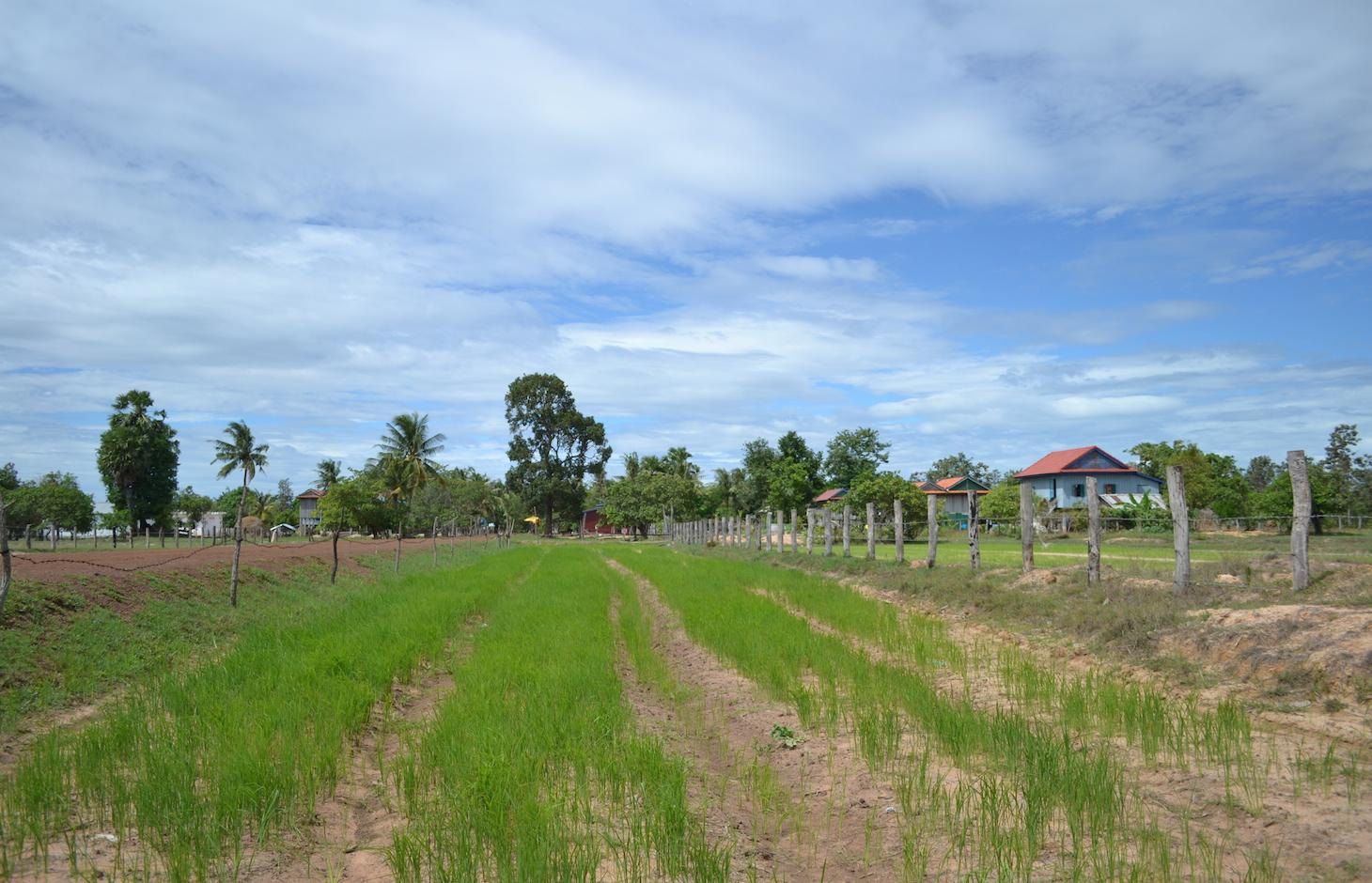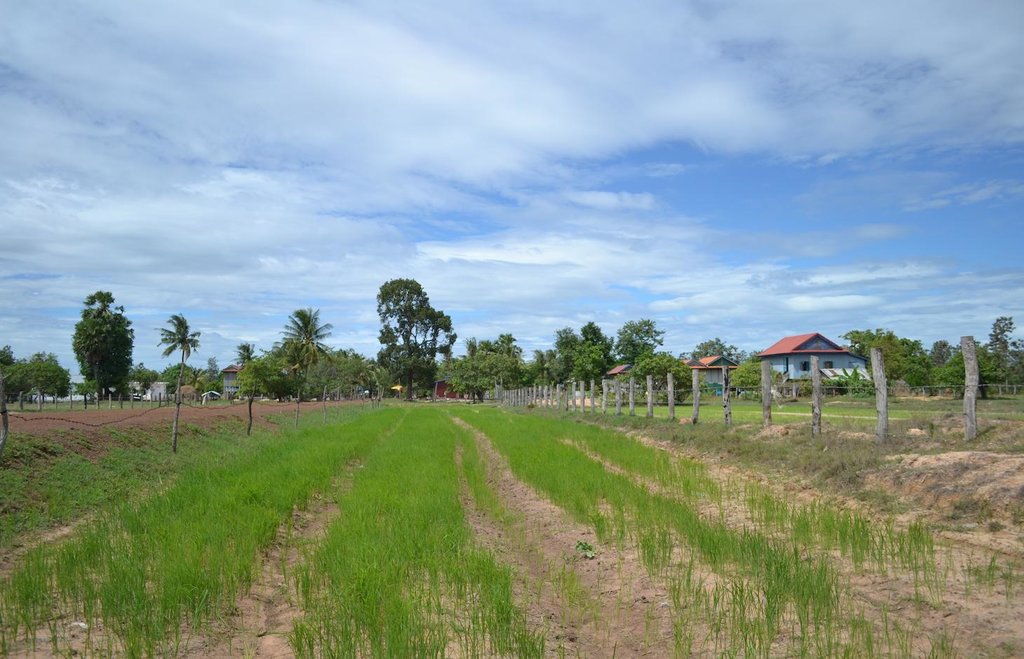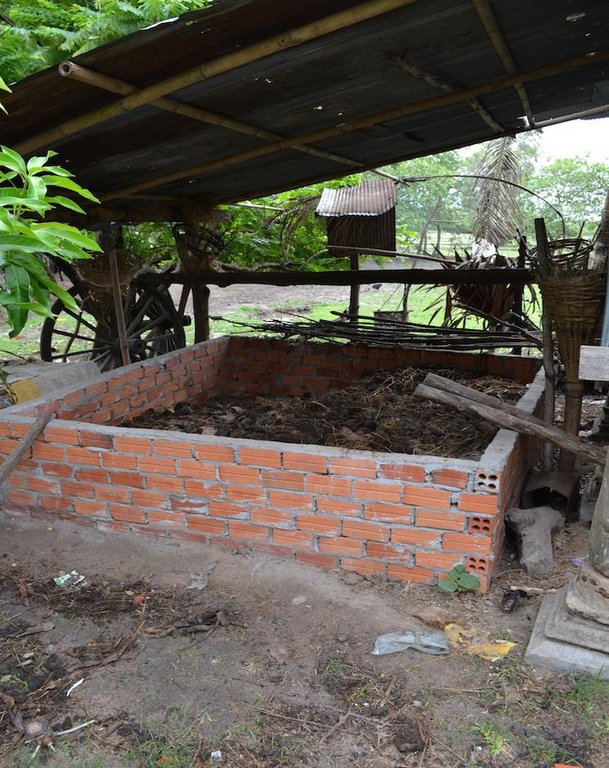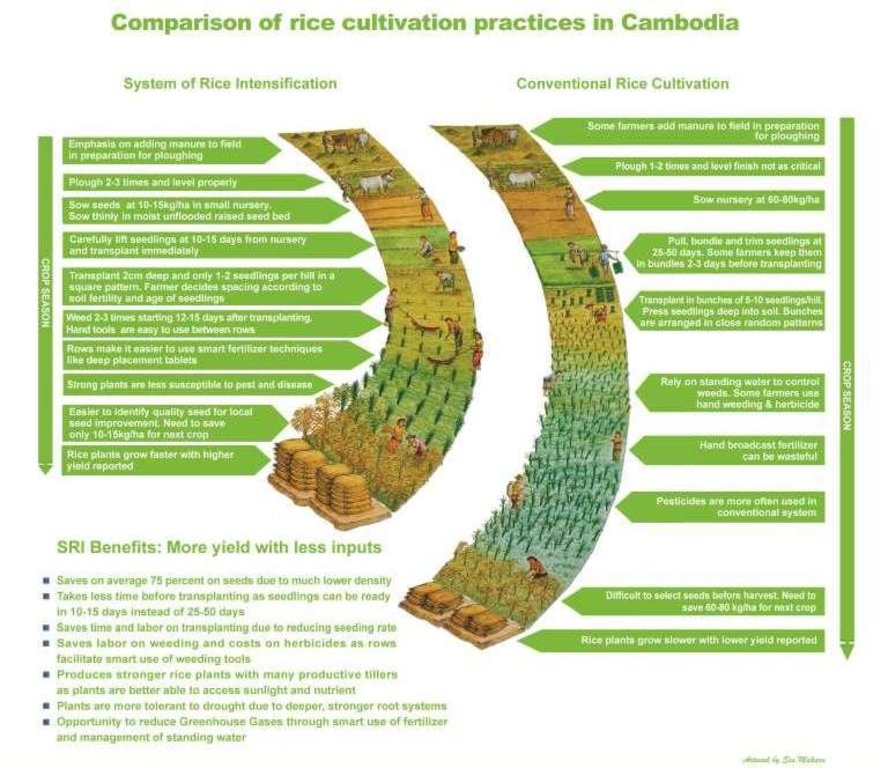Adapted System of Rice Intensification (SRI) principles in Kampong Chhnang [Camboja]
- Criação:
- Atualização:
- Compilador/a: Christoph Kaufmann
- Editor: –
- Revisores: Deborah Niggli, Alexandra Gavilano
ការទទួលយកប្រពន្ធ័ប្រពលវប្បកម្មដំណំាស្រូវក្នុងខេត្តកំពុងឆ្នំាង (Khmer)
technologies_1224 - Camboja
Veja as seções
Expandir tudo Recolher tudo1. Informação geral
1.2 Detalhes do contato das pessoas capacitadas e instituições envolvidas na avaliação e documentação da tecnologia
Especialista em GST:
Khun Lean Hak
SOFDEC/LAREC, www.sofdec.org
Especialista em GST:
Especialista em GST:
Say Mesa
SOFDEC
Camboja
Especialista em GST:
Bin Sreytouch
SOFDEC
Camboja
Especialista em GST:
Pith Khonhel
LAREC
Camboja
Nome da(s) instituição(ões) que facilitou(ram) a documentação/ avaliação da Tecnologia (se relevante)
Local Agricultural Research and Extension Centre (LAREC) - CambojaNome da(s) instituição(ões) que facilitou(ram) a documentação/ avaliação da Tecnologia (se relevante)
Society for Community Development in Cambodia (SOFDEC) - Camboja1.3 Condições em relação ao uso da informação documentada através de WOCAT
O/a compilador/a e a(s) pessoa(s) capacitada(s) aceitam as condições relativas ao uso de dados documentados através da WOCAT:
Sim
1.4 Declaração de sustentabilidade da tecnologia descrita
A tecnologia descrita aqui é problemática em relação a degradação da terra de forma que não pode ser declarada uma tecnologia de gestão sustentável de terra?
Não
1.5 Referência ao(s) questionário(s) sobre abordagens GST (documentado(s) usando WOCAT)
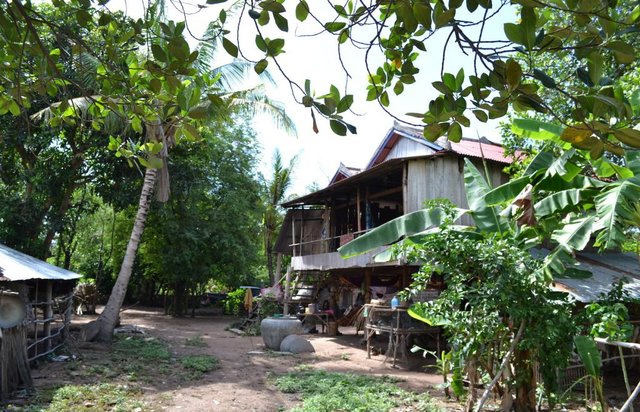
Model farmer [Camboja]
Model farms were introduced by a NGO in order to spread knowledge about SLM (compost, System of Rice Intensification SRI, and other technologies) in the project area.
- Compilador/a: Christoph Kaufmann
2. Descrição da tecnologia de GST
2.1 Descrição curta da tecnologia
Definição da tecnologia:
Some points of the System of Rice Intensification (SRI) technology, like the row transplanting of young seedlings and the use of compost are adapted and applied in Kampong Chhnang.
2.2 Descrição detalhada da tecnologia
Descrição:
The System of Rice Intensification (SRI) was developed in the 1980s in Madagascar, where a French monk worked together with local farmers. The goals of the project were the improvement of the livelihoods of local farmers and the establishment of a farming system that is self-sufficient and thus needs no external inputs. SRI is not a recipe to be followed step by step, but general ideas that need to be adapted to the local conditions. These basic ideas are the following:
- Early transplanting of the seedlings, at the two-leaves-stage (less than 15 days after sowing). At this stage, the plant still has the potential to make a lot of tillers, and develop a strong root system. The seedlings are transplanted carefully, so the plant doesn’t suffer a transplanting shock.
- Wide spacing of single seedlings, usually in squares. The recommended spacing goes from 25 to 50 cm, depending on the soil fertility. This transplanting technique reduces the concurrence between the rice plants and allows the land user easier weeding.
- Aerating the soil. Rice is produced in standing water, but grows better if the roots are aerated. This is usually done with weeding, and additionally either by alternately flooding and letting the soil dry out, or by draining the water regularly. - The soil is fed with compost or manure in order to enhance the fertility and improve the soil structure.
SRI induces changes in deeply rooted local habits with some counter-intuitive knowledge like that more seeds do not produce more yields. Thus the methods have to be adapted locally and yields monitored to fit to other areas.
In Kampong Chhnang, the rice is transplanted at the six-leaves-stage, which is still earlier than conventional transplanting, with spacing of about 15 to 20 cm.
In Kampong Chhnang, the labour availability is low, as many young people work abroad or in the garment industry. Thus the SRI principles, which were taught by an NGO in 2004, were not followed completely, but adapted to this major constraint. The use of very young seedlings requires careful transplanting, which takes time. Thus the seedlings are transplanted at the 6 leaves stage. Due to the low soil fertility in the area, the optimal spacing as tested by CARDI (Cambodian Agricultural Research and Development Institute), was about 20 by 20 cm.
The rice seeds are soaked in water for 24 hours, and then let to germinate in a hot and humid place for two days. Then they are sown on the seed bed, which is prepared with compost. As there is not enough compost available for all the fields, the seedbed is the only place where compost is applied. In the fields chemical fertilizer is used. The seedlings are transplanted after 20 to 25 days (5-6 leaves) single or two per hill, in rows 15 to 20 cm apart. They are transplanted in better levelled fields than conventional transplanting, to allow the use of less water, as the seedlings are smaller than conventional. Otherwise the water management is the same as conventional; due to the lack of labour availability, the fields are not drained as proposed by the NGO 10 years ago. The field is weeded with hoes. The rice is harvested after 85 % of the panicle turned yellow, thus obtaining the best quality.
The analysed area is flat (slope < 2%), with a tropical climate (dry season from November to May and wet season from June to October), and the soils are mostly sandy or loamy. The soil has a low fertility, contains little organic matter, and acidifies. The area has been deforested a long time ago, and the groundwater table is rather high (1-2 m during the dry season, on the surface during wet season).
Due to climate change, farmers notice more erratic rainfalls, temperature rises and more recurrent droughts. Rice is the predominant crop grown in the area, since it serves as staple food (mix subsistence and commercial activities).
The increasing migration rate (the young generation leaves the villages to work in the cities, garment industry or abroad) results in a decrease of available labour force in the area which has detrimental effects on the agricultural activities. Furthermore, the civil war in the 1970s (Khmer Rouge) led to the loss of agricultural knowledge which different NGOs try to re-establish.
2.3 Fotos da tecnologia
2.5 País/região/locais onde a tecnologia foi aplicada e que estão cobertos nesta avaliação
País:
Camboja
Região/Estado/Província:
Kampong Chhnang
Especificação adicional de localização:
Cher Kroev
Especifique a difusão da tecnologia:
- Uniformemente difundida numa área
Se a área precisa não for conhecida, indicar a área aproximada coberta:
- 10-100 km2
2.6 Data da implementação
Caso o ano exato seja desconhecido, indique a data aproximada:
- 10-50 anos atrás
2.7 Introdução da tecnologia
Especifique como a tecnologia foi introduzida:
- através de projetos/intervenções externas
Comentários (tipos de projeto, etc.):
In 2004, SRI was introduced to the land user of this case study by SOFDEC. Then the farmers adapted and transformed some steps.
3. Classificação da tecnologia de GST
3.1 Principal/principais finalidade(s) da tecnologia
- Melhora a produção
3.2 Tipo(s) atualizado(s) de uso da terra onde a tecnologia foi aplicada

Terra de cultivo
- Cultura anual
- rice
Número de estações de cultivo por ano:
- 1
Especifique:
Longest growing period in days: 210, Longest growing period from month to month: June-December
Comentários:
Major land use problems (compiler’s opinion): Lack of organic matter, lack of water retention in soil, irregularity of rainfall, low soil fertility (sandy soil), monocultures, bare soil during dry season, ploughing.
Major land use problems (land users’ perception): Low soil fertility, sandy soil with low water retention.
3.4 Abastecimento de água
Abastecimento de água para a terra na qual a tecnologia é aplicada:
- Misto de precipitação natural-irrigado
3.5 Grupo de GST ao qual pertence a tecnologia
- Gestão integrada de fertilidade do solo
3.6 Medidas de GST contendo a tecnologia

Medidas agronômicas
- A1: cobertura vegetal/do solo
- A2: Matéria orgânica/fertilidade do solo
Comentários:
Type of agronomic measures: better crop cover, manure / compost / residues
3.7 Principais tipos de degradação da terra abordados pela tecnologia

Deteriorização química do solo
- Cn: declínio de fertilidade e teor reduzido de matéria orgânica (não causado pela erosão)
- Ca: acidificação
Comentários:
Main causes of degradation: soil management (The soil is ploughed and left bare for weeks in the dry season), crop management (annual, perennial, tree/shrub) (Rice monocultures), over-exploitation of vegetation for domestic use (No organic matter is left on the fields), labour availability (High migration rates.), education, access to knowledge and support services (Khmer Rouge regime led to the loss of agricultural knowledge.)
3.8 Redução, prevenção ou recuperação da degradação do solo
Especifique o objetivo da tecnologia em relação a degradação da terra:
- Prevenir degradação do solo
- Reduzir a degradação do solo
4. Especificações técnicas, implementação de atividades, entradas e custos
4.1 Desenho técnico da tecnologia
Especificações técnicas (relacionada ao desenho técnico):
Cambodia
Date: 25.10.2011
Technical knowledge required for field staff / advisors: high
Technical knowledge required for land users: moderate
Main technical functions: increase in nutrient availability (supply, recycling,…)
Secondary technical functions: increase in organic matter
Better crop cover
Material/ species: Rice
Remarks: Single or 2 young rice seedlings per hill, in rows, space 15-20 cm
Manure / compost / residues
Material/ species: 2 – 3 t of compost for the seed bed (0.25 ha, transplanted on 1 ha), 75 kg/ha after transplanting.
Quantity/ density: 2-3 t
Autor:
Luy Pisey Rith, Oxfam America, #94, Russian Boulevard, Sangkat Teuk Laak I, Khan Toul Kork, Phnom Penh, Cambodia
4.2 Informação geral em relação ao cálculo de entradas e custos
Indique a média salarial da mão-de-obra contratada por dia:
4.50
4.4 Custos e entradas necessárias para a implantação
| Especifique a entrada | Unidade | Quantidade | Custos por unidade | Custos totais por entrada | % dos custos arcados pelos usuários da terra | |
|---|---|---|---|---|---|---|
| Equipamento | Compost house | 1,0 | 15,0 | 15,0 | 33,0 | |
| Custos totais para a implantação da tecnologia | 15,0 | |||||
| Custos totais para o estabelecimento da Tecnologia em USD | 15,0 | |||||
4.5 Atividades recorrentes/manutenção
| Atividade | Periodicidade/frequência | |
|---|---|---|
| 1. | Ploughing the seed bed (either part of the paddy fields or different field) | 1 / year |
| 2. | Put seeds 24 hours in water | 1 / year |
| 3. | Cover the seeds in a warm place for incubation until they sprout (approximately 2 days, temperatures between 37-40 °C), plant the seedlings in seed bed and let them grow for about 20 - 25 days | 1 / year |
| 4. | Ploughing of rice paddy field | 2 / year |
| 5. | Pull the seedling from seed bed, row transplanting of young rice seedlings (20-25 days): 1-2 seedlings per hill, not too deep into the soil, in 1-2 cm of water. | 1 / year |
| 6. | Add chemical fertilizer to the paddy fields (20 days after transplanting) | 1 / year |
| 7. | Weed control (easier because of row transplanting), done manually | 2 / year |
| 8. | Harvest rice manually when plant is 85% mature. | 1 / year |
4.6 Custos e entradas necessárias pata a manutenção/atividades recorrentes (por ano)
| Especifique a entrada | Unidade | Quantidade | Custos por unidade | Custos totais por entrada | % dos custos arcados pelos usuários da terra | |
|---|---|---|---|---|---|---|
| Mão-de-obra | labour | ha | 1,0 | 228,0 | 228,0 | 100,0 |
| Equipamento | animal traction | ha | 1,0 | 56,0 | 56,0 | 100,0 |
| Material vegetal | seeds | ha | 1,0 | 15,0 | 15,0 | 100,0 |
| Fertilizantes e biocidas | fertilizer | ha | 1,0 | 55,0 | 55,0 | 100,0 |
| Fertilizantes e biocidas | compost/manure | ha | 1,0 | 10,0 | 10,0 | 100,0 |
| Custos totais para a manutenção da tecnologia | 364,0 | |||||
| Custos totais de manutenção da Tecnologia em USD | 364,0 | |||||
Comentários:
Machinery/ tools: Plough; a hand weeder can be used for higher yields but not enough labour is available on the fields. 1 ha; farmer owns 2 ha; year 2014
4.7 Fatores mais importantes que afetam os custos
Descreva os fatores mais determinantes que afetam os custos:
The factor affecting the costs the most is the labour. SRI is labour intensive; the farmer needs twice as much time for a SRI field than for a conventional field. This is the reason he makes only a few of the steps he was taught 10 years ago by SOFDEC.
5. Ambiente natural e humano
5.1 Clima
Precipitação pluviométrica anual
- <250 mm
- 251-500 mm
- 501-750 mm
- 751-1.000 mm
- 1.001-1.500 mm
- 1.501-2.000 mm
- 2.001-3.000 mm
- 3.001-4.000 mm
- > 4.000 mm
Especificações/comentários sobre a pluviosidade:
1486.45 mm 2013 in Kampong Chhnang
Zona agroclimática
- Subúmido
Thermal climate class: tropics. 27-35°C
5.2 Topografia
Declividade média:
- Plano (0-2%)
- Suave ondulado (3-5%)
- Ondulado (6-10%)
- Moderadamente ondulado (11-15%)
- Forte ondulado (16-30%)
- Montanhoso (31-60%)
- Escarpado (>60%)
Formas de relevo:
- Planalto/planície
- Cumes
- Encosta de serra
- Encosta de morro
- Sopés
- Fundos de vale
Zona de altitude:
- 0-100 m s.n.m.
- 101-500 m s.n.m.
- 501-1.000 m s.n.m.
- 1.001-1.500 m s.n.m.
- 1.501-2.000 m s.n.m.
- 2.001-2.500 m s.n.m.
- 2.501-3.000 m s.n.m.
- 3.001-4.000 m s.n.m.
- > 4.000 m s.n.m.
5.3 Solos
Profundidade do solo em média:
- Muito raso (0-20 cm)
- Raso (21-50 cm)
- Moderadamente profundo (51-80 cm)
- Profundo (81-120 cm)
- Muito profundo (>120 cm)
Textura do solo (solo superficial):
- Grosso/fino (arenoso)
- Médio (limoso, siltoso)
Matéria orgânica do solo superficial:
- Médio (1-3%)
- Baixo (<1%)
5.4 Disponibilidade e qualidade de água
Lençol freático:
< 5 m
Disponibilidade de água de superfície:
Precário/nenhum
Qualidade da água (não tratada):
Água potável precária (tratamento necessário)
Comentários e outras especificações sobre a qualidade e a quantidade da água:
Ground water table: during dry season
Availability of surface water: during dry season
5.5 Biodiversidade
Diversidade de espécies:
- Baixo
5.6 Características dos usuários da terra que utilizam a tecnologia
Orientação de mercado do sistema de produção:
- misto (subsistência/comercial)
Rendimento não agrícola:
- 10-50% de toda renda
Nível relativo de riqueza:
- Pobre
- Média
Indivíduos ou grupos:
- Indivíduo/unidade familiar
Nível de mecanização:
- Trabalho manual
- Tração animal
Gênero:
- Mulheres
- Homens
Indique outras características relevantes dos usuários da terra:
Land users applying the Technology are mainly common / average land users
Population density: 10-50 persons/km2
Annual population growth: 0.5% - 1%
Off-farm income specification: Handicrafts, factory work, remittances
5.7 Área média de terrenos utilizados pelos usuários de terrenos que aplicam a Tecnologia
- < 0,5 ha
- 0,5-1 ha
- 1-2 ha
- 2-5 ha
- 5-15 ha
- 15-50 ha
- 50-100 ha
- 100-500 ha
- 500-1.000 ha
- 1.000-10.000 ha
- > 10.000 ha
É considerado pequena, média ou grande escala (referente ao contexto local)?
- Pequena escala
5.8 Propriedade de terra, direitos de uso da terra e de uso da água
Propriedade da terra:
- Comunitário/rural
- Indivíduo, não intitulado
Direitos do uso da terra:
- Comunitário (organizado)
- Indivíduo
Direitos do uso da água:
- Acesso livre (não organizado)
Comentários:
Land users have a title that is not recognized by the state
5.9 Acesso a serviços e infraestrutura
Saúde:
- Pobre
- Moderado
- Bom
Educação:
- Pobre
- Moderado
- Bom
Assistência técnica:
- Pobre
- Moderado
- Bom
Emprego (p. ex. não agrícola):
- Pobre
- Moderado
- Bom
Mercados:
- Pobre
- Moderado
- Bom
Energia:
- Pobre
- Moderado
- Bom
Vias e transporte:
- Pobre
- Moderado
- Bom
Água potável e saneamento:
- Pobre
- Moderado
- Bom
Serviços financeiros:
- Pobre
- Moderado
- Bom
6. Impactos e declarações finais
6.1 Impactos no local mostrados pela tecnologia
Impactos socioeconômicos
Produção
Produção agrícola
Comentários/especificar:
Around 20% more yields
Risco de falha de produção
Comentários/especificar:
Seedbed can be irrigated
Disponibilidade e qualidade de água
Demanda por água para irrigação
Comentários/especificar:
The seedbed is smaller, so less irrigation is needed in the beginning of the rainy season/dry spell
Renda e custos
Despesas com insumos agrícolas
Comentários/especificar:
Used half the amount of seeds
Rendimento agrícola
Carga de trabalho
Impactos socioculturais
Segurança alimentar/auto-suficiência
Comentários/especificar:
Crop is more tolerant to droughts. He uses less chemical fertilizer since he uses compost
Conhecimento de GST/ degradação da terra
Comentários/especificar:
Knowledge about composting
Atenuação de conflitos
contribution to human well-being
Comentários/especificar:
SRI increased the rice yields and reduces the use of seeds.
Impactos ecológicos
Solo
Matéria orgânica do solo/carbono abaixo do solo
Comentários/especificar:
Compost only used in seedbed
6.3 Exposição e sensibilidade da tecnologia às mudanças climáticas graduais e extremos/desastres relacionados ao clima (conforme o ponto de vista dos usuários da terra)
Mudança climática gradual
Mudança climática gradual
| Estação do ano | aumento ou diminuição | Como a tecnologia lida com isso? | |
|---|---|---|---|
| Temperatura anual | aumento | não conhecido |
Extremos (desastres) relacionados ao clima
Desastres meteorológicos
| Como a tecnologia lida com isso? | |
|---|---|
| Temporal local | bem |
| Tempestade de vento local | não conhecido |
Desastres climatológicos
| Como a tecnologia lida com isso? | |
|---|---|
| Seca | bem |
Desastres hidrológicos
| Como a tecnologia lida com isso? | |
|---|---|
| Inundação geral (rio) | não bem |
Outras consequências relacionadas ao clima
Outras consequências relacionadas ao clima
| Como a tecnologia lida com isso? | |
|---|---|
| Período de crescimento reduzido | não conhecido |
6.4 Análise do custo-benefício
Como os benefícios se comparam aos custos de implantação (do ponto de vista dos usuários da terra)?
Retornos a curto prazo:
positivo
Retornos a longo prazo:
muito positivo
Como os benefícios se comparam aos custos recorrentes/de manutenção(do ponto de vista dos usuários da terra)?
Retornos a curto prazo:
positivo
Retornos a longo prazo:
muito positivo
Comentários:
The building of the compost house (only establishment cost) was subsidized, so he had to pay only 5 $ to build it. On the long term the addition of compost is very positive for the soil fertility.
6.5 Adoção da tecnologia
De todos aqueles que adotaram a Tecnologia, quantos o fizeram espontaneamente, ou seja, sem receber nenhum incentivo/ pagamento material?
- 11-50%
Comentários:
67% of land user families have adopted the Technology with external material support
33% of land user families have adopted the Technology without any external material support
20 land user families have adopted the Technology with external material support
10 land user families have adopted the Technology without any external material support
Due to the lack of labour force less farmers are applying the SRI technology.
6.7 Pontos fortes/vantagens/oportunidades da tecnologia
| Pontos fortes/vantagens/oportunidades na visão do usuário da terra |
|---|
| Improved soil structure and fertility due to the compost addition. |
| Pontos fortes/vantagens/oportunidades na visão do/a compilador/a ou de outra pessoa capacitada |
|---|
| Improved yields (ca. 20%) |
| Better price possible if he applied SRI without chemical fertilizer and if he sold the yield on the organic market. |
6.8 Pontos fracos, desvantagens/riscos da tecnologia e formas de superá-los
| Pontos fracos/desvantagens/riscos na visão do usuário da terra | Como eles podem ser superados? |
|---|---|
| The seedlings have to be treated with care. | More yields, less dependent on off-farm income. |
| Increases the workload. | Change the local agriculture to more perennials and animals to produce more organic matter (shift toward integrated farming). |
| SRI needs more compost than is available. |
| Pontos fracos/vantagens/riscos na visão do/a compilador/a ou de outra pessoa capacitada | Como eles podem ser superados? |
|---|---|
| The fields are always flooded, thus there are anaerobic conditions in the root area. | Either, the water can be drained before the rain, or the fields can alternatively be dried out and flooded. |
| The seedlings are much older at the 6 leaves stage than recommended by SRI. | Experiment with transplanting of younger seedlings. |
7. Referências e links
7.1 Métodos/fontes de informação
- visitas de campo, pesquisas de campo
- entrevistas com usuários de terras
Quando os dados foram compilados (no campo)?
03/07/2014
7.2 Referências às publicações disponíveis
Título, autor, ano, ISBN:
List of documentation about SRI in English
Disponível de onde? Custos?
http://sri.ciifad.cornell.edu/extmats/index.html#english (free)
Links e módulos
Expandir tudo Recolher tudoLinks

Model farmer [Camboja]
Model farms were introduced by a NGO in order to spread knowledge about SLM (compost, System of Rice Intensification SRI, and other technologies) in the project area.
- Compilador/a: Christoph Kaufmann
Módulos
Não há módulos


